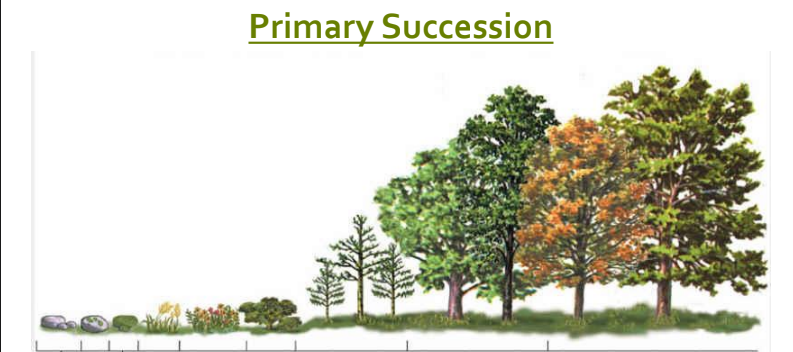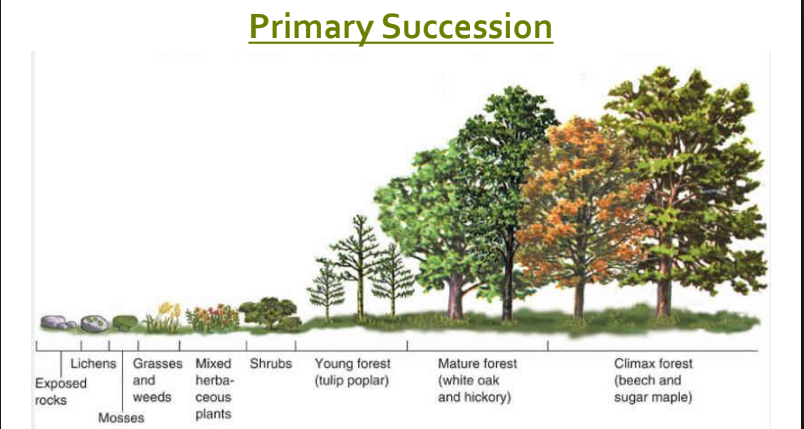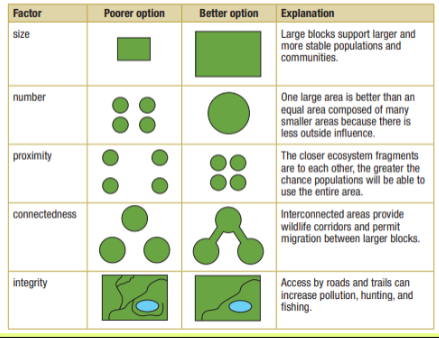SNC 1W1 Ecosystems Unit
1/96
There's no tags or description
Looks like no tags are added yet.
Name | Mastery | Learn | Test | Matching | Spaced |
|---|
No study sessions yet.
97 Terms
salt concentration in Aquatic ecosystems
- Fresh water = < 1%.
- Ocean = 3%
Oligotrophic bodies of water
Low nutrient levels
deep and clear
photosynthetic organisms have difficulty obtaining enough nutrients
Eutrophic bodies of water
High nutrient levels
Photosynthetic organisms grow rapidly and support a large biomass of consumers.
are often clouded with suspended microscopic plankton.
Marsh
Constantly flooded with water from a
specific source (e.g. river, lake, ocean, etc.)Rich in mineral deposits
Plants are mostly grasses, reeds, and rushes.
Swamp
- Waterlogged soil
with areas of dry land - Most develop from
marshes - found on the
edge of rivers,
lakes or oceans - abundance of
trees.
Bog
sealed clay bottom prevents water from seeping out.
Form when plants decay in lakes and fill them up, forming peat.
Lack nutrients due to slow rate of decay.
Mosses, fungi, small shrubs.
open ocean
nutrient poor and unable to support many photosynthesizing organisms.
Deep ocean
lightless environment, so photosynthesis is impossible.
intertidal zone location
The area between the low-tide and high-tide lines on ocean coastlines.
adaptations of intertidal species
Protective body coatings and tough tissues to withstand wave action.
common species in the intertidal zone
Seaweeds, barnacles, sea stars, and urchins.
Limiting Factor
Any factor that restricts the size of a population (eg. food(biotic) or water(aboitic)
Tolerance Range
The range of abiotic factors within which a species can survive.
Mutualism
An interaction where both individuals benefit each other.
Commensalism
An interaction where one individual benefits and the other neither benefits nor is harmed.
Parasitism
An interaction where one individual lives on or in and feeds on a host organism.
Predation
An interaction where one individual (predator) feeds on another (prey).
Competition
An interaction where two individuals vie for the same resource.
Carrying Capacity
The upper sustainable limit that an ecosystem can support, determined by resource availability and population density.
Biome
A large geographical region defined by climate, with a specific set of biotic and abiotic features.
Tundra- Abiotic Factors
• Low temperatures
• Short growing season
• Permafrost
• Precipitation from 0 to 25 cm/year
• Poor soil quality
Tundra- Biotic Factors
• Low diversity
• Rapid-flowering plants
• Mosses and lichens
• Caribou
• Ptarmigan
• Lemmings
• Arctic foxes
Boreal Forest (Taiga) - Abiotic
• Warmer than tundra
• No permafrost
• Changeable weather
• Soil contains some water and is acidic
• Precipitation 40 cm/year or more
Boreal Forest (Taiga) - Biotic
• Coniferous trees
• Seed-eating birds
• Squirrels
• Voles
• Snowshoe hares
• Black bears
• Pine martens
• Grey wolves
Temperate Deciduous Forest - Abiotic
• Longer growing season than boreal forest
• Higher temperatures than tundra or
boreal forest (4 seasons)
• Fertile soil
• Precipitation up to 100 cm/year
Temperate Deciduous Forest - Biotic
• Deciduous trees and other flowering
plants
• Tree and ground squirrels
• Many insects
• Shrews and mice
• Deer
• Black bears
• Hummingbirds
• Weasels
Grassland - Abiotic
• Longer growing season than boreal
forest
• Higher temperatures than tundra or
boreal forest
• Rich, fertile soil
• Precipitation from 25 to 75 cm/year
• No trees due to less rainfall than the
deciduous forest biome
Grassland - Biotic
• Fescue grasses
• Grasshoppers
• Bison
• Voles and mice
• Snakes
• Hawks
• Coyotes
Mountain Forest - Abiotic
• Temperatures vary with elevation
• Cool summers
• Windy conditions
• Heavy precipitation on leeward side of
mountains
• Fast-flowing rivers
Mountain Forest - Biotic
• Marmots
• Squirrels
• Elk
• Black and Grizzly bear
• Cougar
• Large coniferous trees
• Ferns
Water cycle
Liquid water evaporates into water vapour, condenses to form clouds, and precipitates back to earth.
Niche
The way an organism interacts with other species and its environment, what it feeds on, what eats it and how it behaves.
Herbivore
An animal that eats plants or other producers
Omnivore
An animal that eats both plants and animals
Carnivore
An animal that eats other animals
Scavenger
An animal that feeds on the remains of another
organism.
Food chain
a sequence of organisms
each feeding on the next, showing how energy is transferred
from one organism to another
Trophic level
The position or feeding level of an organism in a food chain.
Food web
a series of food chains that are
interconnected.
indicator species
essential to food web
pyramid of energy
10% of energy at one trophic level is transferred to the next. (why so few trophic levels)
pyramid of numbers
-Show numbers of organisms
-because of energy lost at organisms at the top of the pyramid need more organisms to support them.
- no account for the varying support of organisms
pyramid of biomass
biomass (in kg) of different organisms following a food chain
More accurate version of energy transfer than a pyramid of numbers.
Law of Conservation of Mass
particles of matter cannot be created or destroyed; they must be produced or obtained from existing chemicals.
carbon cycle
The movement of carbon between abiotic and biotic parts of an ecosystem, primarily through photosynthesis and respiration.
Habitat
Where an organism lives.
Atmosphere
The layer of gases surrounding Earth, critical to life, moderating surface temps(too hot days, too cold nights) and blocking most U.V. radiation.
Lithosphere
The rocky outer shell of Earth, consisting of rocks and minerals that make up mountains, ocean floors, and solid landscape.
Hydrosphere
All of the Earth's water in solid, liquid, and gas form, including oceans, lakes, ice, rivers, groundwater, and clouds. oceans are 97% of water.
Biosphere
The zone around Earth where life can exist, very thin compared to Earth itself.
Ecosystem
All of the living organisms and their physical and chemical environment
Abiotic factors
Non-living physical and chemical components in an ecosystem (e.g. sunlight, temperature, wind, water, minerals).
Biotic factors
The living components of an ecosystem, including all organisms, their remains, and their products or wastes.
Species
A group of similar organisms that can reproduce and whose offspring can also reproduce.
Population
All members of the SAME species found in the same area.
Community
Members of DIFFERENT species found in the same area.
Sustainability
Ability to maintain natural ecological conditions or processes without interruptions, weakening, or loss of value.
Sun's Radiant Energy
The Sun's radiant energy provides us with invisible energy (ex. UV rays) and visible or light energy.
Absorption of energy from the sun
-70% is absorbed by the Earth and converted to thermal energy
-30% is reflected by the clouds or Earth's surface
-0.023% is absorbed by plants.
Photosynthesis
organisms convert light energy into chemical energy
Photosynthesis Equation
carbon dioxide + water (light energy) sugar + oxygen
Consumers
Cannot photosynthesize and must consume other organisms for food.
Producers
Make their own food (glucose) through photosynthesis.
Cellular Respiration
To use the sugar made from photosynthesis and obtain its stored energy.
Cellular Respiration Equation
sugar + oxygen → carbon dioxide + water + energy.
Equilibrium
A state where biotic and abiotic features of an ecosystem remain relatively constant over time and populations are healthy and stable. Biomes have a greater equilibrium than smaller ecosystems.
Ecological Succession
The process of establishing and replacing a community following a disturbance such as a geologic event (e.g. volcanic eruption), a fire, or human activity (e.g. deforestation).
Primary Succession
Succession that occurs on soil or bare rock, where no life previously existed (e.g., following a volcanic eruption).
Secondary Succession
Succession that follows a disturbance that disrupts but does not destroy the community (e.g., regrowth of an area following a forest fire).
Pioneer Species
The first species to colonize an area during ecological succession.
Climax Community
A stable, mature community that undergoes little or no change in species over time.
Aquatic Succession
The process by which a body of water, such as a pond, gradually transitions into a land ecosystem through the accumulation of sediments and decaying organisms.
Shoreline Succession
The succession of plants in a shoreline environment that are adapted to harsh conditions, which eventually leads to development of woodlands


Biodiversity
The variety of life found in an area.
Species Richness
The number of species in an area, Higher closer to the equator.
Extinction
The dying out of a species.
Habitats are being destroyed through
deforestation
urban and agricultural expansion
pollution
climate change
Extirpated
A species that can no longer be found in a specific area.
Endangered
A species facing imminent extirpation or extinction.
Threatened
A species likely to become endangered if factors reducing its survival are not changed.
Special Concern
A species that may become threatened or endangered because of a combination of factors.
What has replaced much of Southern Ontario's temperate forest ecosystem?
Farmland, cities, and highways.
Fragmentation of Terrestrial Ecosystems
the conversion of large areas of natural ecosystems into farmland and urban developments.
Fragmentation of natural ecosystems reduces their sustainability.
What are the ideal conditions in wetlands that make them suitable for agriculture?
Flat terrain, deep nutrient-rich soil, and an abundant water supply.
How can ecosystem sustainability be enhanced ?
One large area
Interconnected fragments
Closer fragments
Fewer trails/roads

What is a non-native species?
An organism introduced to a new ecosystem where it wasn't naturally found, usually by human means, unintentional or deliberate.
Why do introductions of non-native species usually fail?
The organism is in an ecosystem outside its tolerable range for abiotic factors.
What are the potential outcomes of a successful introduction of a non-native species?
It can be beneficial, harmful, or have no effect on its new ecosystem.
Why may a successful introduction be harmful ?
It can compete with native species for food, resources, and space
disrupt the equilibrium of an ecosystem
They have a lack of predators
damage agriculture, and spread diseases.
What defines an invasive species?
A species that is harmful to its new ecosystem.
How has globalization affected the introduction of non-native species?
Increased world traveling and the import/export of goods have made unintentional introductions more common.
Methods to control invasive species
chemical (e.g., pesticides)
mechanical (e.g., hunting, trapping)
biological (introducing another species that doesn't affect natives).
Ecological Impacts of Invasive Species
competing native species for resources
altering nutrient cycles and energy flow
Economic Impacts of Invasive Species
Damage to forests and agriculture Causes financial loss
Impacts of Invasive Species on Tourism
Impacts on wildlife viewing, fishing, and water-based recreation
Impacts of Invasive Species on health
Disease causing organisms
Pesticides used to control the species